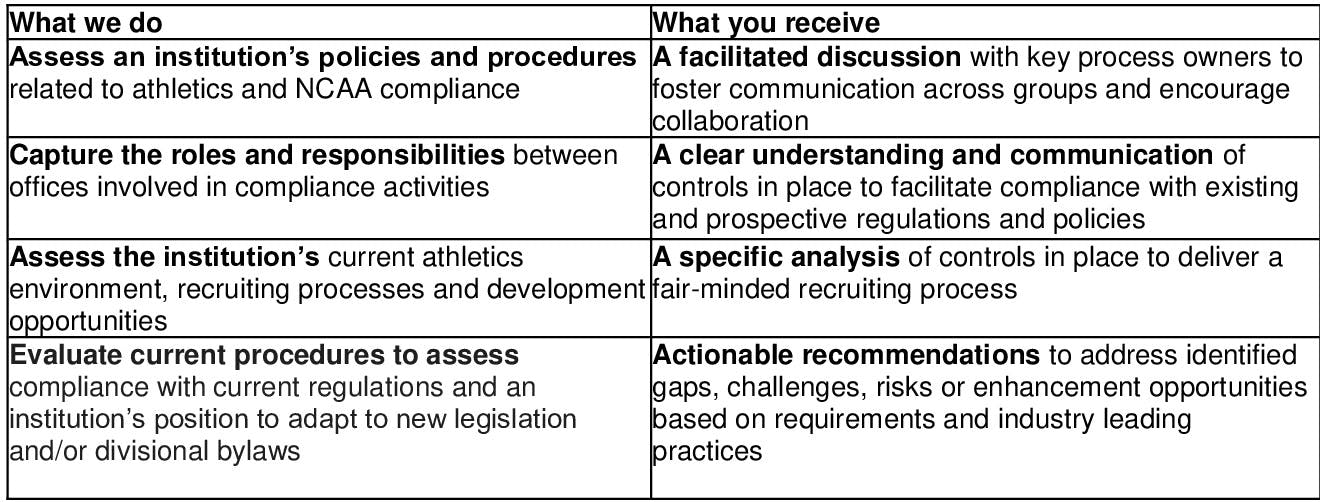On Jan. 20, 2022, the National Collegiate Athletic Association (NCAA) voted to approve a new constitution that will be effective Aug. 1, 2022. In its most notable change, the NCAA provides the divisions (i.e., Division I, Division II, and Division III) with greater authority to reorganize and restructure. Among other updates, each division will have oversight of its own budget, expenditures and financial distribution to its members.
The principles outlined in the new constitution include:
- An emphasis on the academic experience and intercollegiate athletics as a component of an institution’s broader educational program
- Continued prohibition on pay-for-play but allowance for additional educational and other benefits, such as those for name, image and likeness (NIL) in accordance with guidelines established by each division
- The responsibility of member institutions to conduct programs that demonstrate fundamental values, including respect, fairness and ethical conduct
- Support and enhancement of the physical and mental health and safety of student athletes
- Affirmation of an institution’s responsibility to maintain institutional control of its athletics programs
- Promotion of diversity, inclusion and gender equity in athletics activities, hiring practices, coaching and professional relationships and leadership and advancement opportunities
- Relegation of recruiting standards to the divisions
Under its new constitution, the NCAA assigns a great deal of its authority to the individual divisions while retaining responsibility for activities, such as liaising with the United States Olympic and Paralympic Committees and conducting all NCAA championships. By retaining the responsibility for conducting all NCAA championships, the NCAA retains the ability to collect and distribute revenue from the Division I Men’s Basketball Championship (i.e., March Madness), the main source of revenue for the NCAA, to its member institutions. The new constitution does not change the revenue Division II and Division III allocations that it established more than 25 years ago. While the new constitution does not expressly discuss revenue sharing, which is a point of contention for its critics, it does state that Divisions II and III will receive 4.37% and 3.18% of all operating revenue sources respectively.
The number of members on the Board of Governors reduced from 21 to nine and will include representation from the three divisions, independent members and a graduate student athlete. The Board of Governors will continue to provide financial and strategic oversight of the Association including, but not limited to, employment and evaluation of the president.
What does all this mean for athletic departments and compliance officers? It means that more changes are on the way. To support their respective governance models, each division will need to adopt additional changes. Before Aug. 1, each division will need to:
- Set standards for academic eligibility
- Determine its governing structure and membership
- Establish guidelines for student athlete benefits including name, image and likeness (NIL)
- Establish policies and procedures to enforce NCAA and divisional rules
- Determine the sports and criteria for which it will conduct a national championship
- Determine policies governing the formation and operation of conferences
- Oversee the operations of its member conferences
- Ensure member institutions comply with specific NCAA provisions including those requiring members to submit compliance and financial documentation
Individual conferences may also adopt additional policies, procedures or rules if divisions relegate certain authorities to the conferences.
Institutions will need to understand how changes in their divisions and conferences may affect their athletic programs and operations.
Other notable outcomes
In addition to adopting a new constitution, the NCAA made another notable change during its recent convention. In line with its decision to relegate authority to the respective divisions, the NCAA has adopted a “sport-by-sport” approach to transgender participation by giving the individual sports autonomy to establish rules for participation. The new policy, which took effect immediately, aligns with the International Olympic Committee's (IOC) policy adopted on Nov. 16, 2021 in which transgender participation is determined by the national governing body (NGB) of each sport. In the absence of an NGB policy, that sport’s international federation policy would apply or, in the event there is no international federation policy, the IOC has criteria that would be followed.
With this policy effective for the 2022 winter championships, institutions with transgender student athletes should look to understand how this policy impacts their current athletes and what documentation is required prior to their sport’s championship selections. Moving forward, all institutions need to be aware of the policy change and requirements to document sport-specific testosterone levels starting in the 2022-23 academic year.


